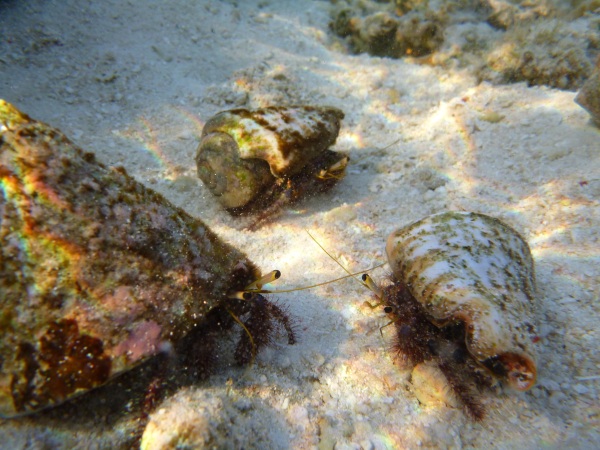Shell Selection
The inhabited gastropod shell is one of the most interesting and important considerations for any aspect of hermit crab biology. As part of this project, an experiment examining the consequences of shell selection was conducted at the Heron Island Research Station. A downloadable pdf is provided below along with the paper abstract.
Downloadable pdf:
BIOL3211 Storm Martin 2012.pdf
Abstract
Shell selection is an important determinant of survival and possibly reproductive success amongst the hermit crabs, Paguroidea. The evolution of hermit crabs is closely tied with that of gastropods and hence it is reasonable to suggest a selective pressure for an ability to assess and choose an optimal shell. Three species of diogenid paguroids were collected from Heron Island, Queensland, Australia. Hermit crabs were turned aperture upwards and the times taken to emerge and to fully right were recorded. Dardanus megistos was more efficient than the other two species when righting itself and there was some evidence that the different species were utilising different shells. Strombus luhuans, the red-lipped stromb and Trochus shells were the most commonly collected shells with hermit crab occupants. Both the emergence and righting performance was significantly higher in strombs than Trochus, though Trochus shells are very heavy relative to size and are proposed to offer the greatest protection from predators amongst the shells considered. Whether or not shell occupation frequencies simply reflect availability within the environment, the consequences of shell choice remain real. Certainly different shells can be considered to influence performance and fitness along multiple measures and it is likely that shell choice, via predation, is one of the strongest selective pressures on hermit crabs.
 |
|
The three Dardanus lagopodes in this photo are all similar in size, however, the Trochus shell carried by the one on the left is much larger and heavier than the stombs carried by the other two. Presumably those with lighter shells can move and right themselves more easily than those with heavier shells. But perhaps a Trochus shell offers greater protection from predators? Photo: Storm Martin, Heron Island, 2012. |
|